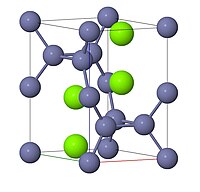Laves phase

Imagine that you have some building blocks that you want to make a big tower with. However, you don't want the tower to be easy to knock over. You could stack the blocks one on top of the other, but that could make the tower wobbly. So instead, you start building your tower by putting the blocks in a special pattern. This pattern is called the Laves phase.
The Laves phase is a special way of arranging atoms in a material. It is named after a scientist named Fritz Laves who first discovered it. In this pattern, the atoms are arranged in a very specific way that makes the material very strong and stable.
To understand the Laves phase, think about how you could arrange the building blocks. Instead of stacking them directly on top of each other, you could put one block on the bottom, and then another block next to it. Then you could put another block on top of those two, but in a different spot. This would continue over and over, with each block fitting snugly with the blocks next to it.
Materials that have a Laves phase arrangement of atoms are used in many different applications, such as airplane engines, where strength and stability are critical. The Laves phase is also important in studying the properties of materials and how they behave under different conditions.
The Laves phase is a special way of arranging atoms in a material. It is named after a scientist named Fritz Laves who first discovered it. In this pattern, the atoms are arranged in a very specific way that makes the material very strong and stable.
To understand the Laves phase, think about how you could arrange the building blocks. Instead of stacking them directly on top of each other, you could put one block on the bottom, and then another block next to it. Then you could put another block on top of those two, but in a different spot. This would continue over and over, with each block fitting snugly with the blocks next to it.
Materials that have a Laves phase arrangement of atoms are used in many different applications, such as airplane engines, where strength and stability are critical. The Laves phase is also important in studying the properties of materials and how they behave under different conditions.
